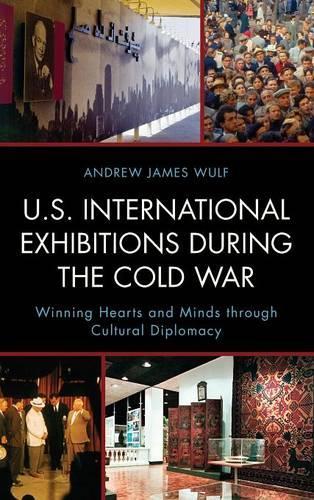
U.S. International Exhibitions during the Cold War: Winning Hearts and Minds through Cultural Diplomacy
(Hardback)
Publishing Details
U.S. International Exhibitions during the Cold War: Winning Hearts and Minds through Cultural Diplomacy
By (Author) Andrew James Wulf
Bloomsbury Publishing PLC
Rowman & Littlefield Publishers
30th January 2015
United States
Classifications
Professional and Scholarly
Non Fiction
Cultural studies
327.20973
Physical Properties
Hardback
356
Width 152mm, Height 229mm
Description
Although cultural diplomacy has become an increasingly fashionable term embraced by academics, foreign-service personnel, and private sector commercial and cultural interests, the very practice of this idea remains conspicuously challenging to define. This book takes on this problem, advancing a new understanding of cultural diplomacy that results from a historical investigation of a single area of government and private sector partnership, and what became in the mid-twentieth century the most prominent manifestation of this alliancethe cultural exhibitions sent abroad to tell Americas story with the goal of winning hearts and minds. To illustrate this point, selected exhibitions and the intentions of the policymakers who proposed them are interrogated for the first time beside archival documentation, writings from the history of design, advertising, science, as well as art historical and museum studies theories that addressvarious aspectsof the history of collecting and display,all of whichexplore the reality of how these exhibitions were conceived and prepared for foreign audiences. Most importantly, personal interviews with the designers and government representatives responsible for the ultimate appearance of these events upturn preconceived notions of how these events came to be. Seventy-five photographs from the exhibits make this history come alive. Through this discussion these questions are answered: What was America showing of itself through these exhibitions And, more urgently, what do these exhibitions tell us about U.S. interest in verisimilitude This investigation spans the crucial years of American exhibitions abroad (1955-1975), beginning with the formation of an official system of exhibiting American commercial wares and political ideas at trade fairs, through official exchanges with the U.S.S.R.,to pavilions at world's fairs, and finally to museum exhibitions that signaled a returnto the display offounding Americanvalues.They are thus complex ideological symbols in which concepts of national identity, globalization, technology, consumerism, design, and image management both coincided and clashed. The investigation of these exhibitions enhances the understanding of a significant chapter of U.S. cultural diplomacy at the height of the Cold War and how America constantly reimagined itself.
Reviews
Andrew Wulf gives us a first-rate study of American cultural and public diplomacy during the Cold War. Not incidentally, it is a marvelous study of international exhibitions and world's fairs as mirrors of Cold War America. -- Robert W. Rydell, Director of the Montana State University Humanities Institute, Montana State University
Meticulously researched and elegantly written, Andrew Wulf's remarkable book deftly reveals the heart of the U.S. government's approach to the Cold War and its attitude to its own identity through the history of its international exhibitions. Wulf's work takes its place on the short shelf of essential texts on the history of U.S. public diplomacy or for that matter any nation's self-representation overseas. -- Nicholas J. Cull, Director of the Master's in Public Diplomacy program at the Center on Public Diplomacy at the University of Southern California, and author, The Cold War and the United States Information Agency: American propaganda and Public Diplomacy, 1946-1989
Author Bio
Andrew James Wulf is a scholar of history who serves as the curator of the Ronald Reagan Presidential Library and Museum, part of the U.S. National Archives. He earned his PhD in Museum Studies from the University of Leicester in the United Kingdom and is a contributor to USCs Center on Public Diplomacy in Los Angeles. He is a recent graduate of the Getty Leadership Institutes management program for museum executives.
